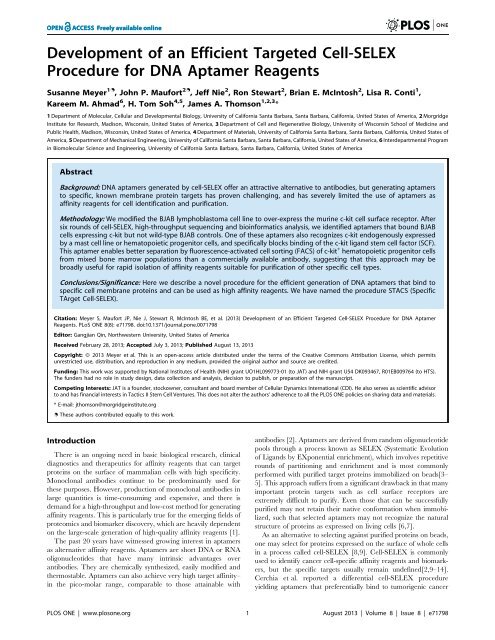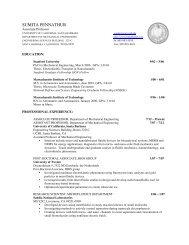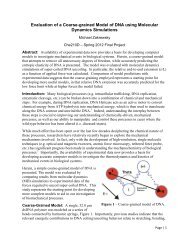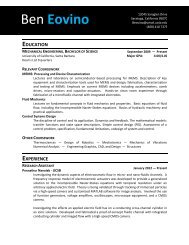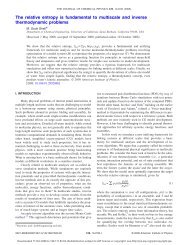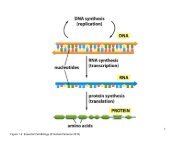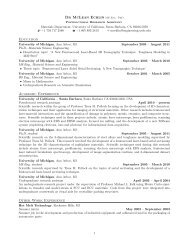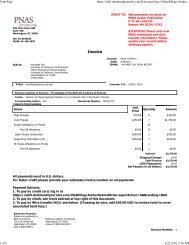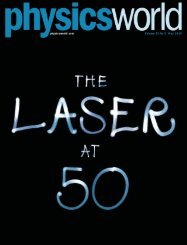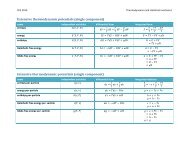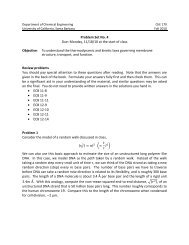Development of an Efficient Targeted Cell-SELEX Procedure for ...
Development of an Efficient Targeted Cell-SELEX Procedure for ...
Development of an Efficient Targeted Cell-SELEX Procedure for ...
Create successful ePaper yourself
Turn your PDF publications into a flip-book with our unique Google optimized e-Paper software.
<strong>Development</strong> <strong>of</strong> <strong>an</strong> <strong>Efficient</strong> <strong>Targeted</strong> <strong>Cell</strong>-<strong>SELEX</strong><strong>Procedure</strong> <strong>for</strong> DNA Aptamer ReagentsSus<strong>an</strong>ne Meyer 1. , John P. Mau<strong>for</strong>t 2. , Jeff Nie 2 , Ron Stewart 2 , Bri<strong>an</strong> E. McIntosh 2 , Lisa R. Conti 1 ,Kareem M. Ahmad 6 , H. Tom Soh 4,5 , James A. Thomson 1,2,3 *1 Department <strong>of</strong> Molecular, <strong>Cell</strong>ular <strong>an</strong>d <strong>Development</strong>al Biology, University <strong>of</strong> Cali<strong>for</strong>nia S<strong>an</strong>ta Barbara, S<strong>an</strong>ta Barbara, Cali<strong>for</strong>nia, United States <strong>of</strong> America, 2 MorgridgeInstitute <strong>for</strong> Research, Madison, Wisconsin, United States <strong>of</strong> America, 3 Department <strong>of</strong> <strong>Cell</strong> <strong>an</strong>d Regenerative Biology, University <strong>of</strong> Wisconsin School <strong>of</strong> Medicine <strong>an</strong>dPublic Health, Madison, Wisconsin, United States <strong>of</strong> America, 4 Department <strong>of</strong> Materials, University <strong>of</strong> Cali<strong>for</strong>nia S<strong>an</strong>ta Barbara, S<strong>an</strong>ta Barbara, Cali<strong>for</strong>nia, United States <strong>of</strong>America, 5 Department <strong>of</strong> Mech<strong>an</strong>ical Engineering, University <strong>of</strong> Cali<strong>for</strong>nia S<strong>an</strong>ta Barbara, S<strong>an</strong>ta Barbara, Cali<strong>for</strong>nia, United States <strong>of</strong> America, 6 Interdepartmental Programin Biomolecular Science <strong>an</strong>d Engineering, University <strong>of</strong> Cali<strong>for</strong>nia S<strong>an</strong>ta Barbara, S<strong>an</strong>ta Barbara, Cali<strong>for</strong>nia, United States <strong>of</strong> AmericaAbstractBackground: DNA aptamers generated by cell-<strong>SELEX</strong> <strong>of</strong>fer <strong>an</strong> attractive alternative to <strong>an</strong>tibodies, but generating aptamersto specific, known membr<strong>an</strong>e protein targets has proven challenging, <strong>an</strong>d has severely limited the use <strong>of</strong> aptamers asaffinity reagents <strong>for</strong> cell identification <strong>an</strong>d purification.Methodology: We modified the BJAB lymphoblastoma cell line to over-express the murine c-kit cell surface receptor. Aftersix rounds <strong>of</strong> cell-<strong>SELEX</strong>, high-throughput sequencing <strong>an</strong>d bioin<strong>for</strong>matics <strong>an</strong>alysis, we identified aptamers that bound BJABcells expressing c-kit but not wild-type BJAB controls. One <strong>of</strong> these aptamers also recognizes c-kit endogenously expressedby a mast cell line or hematopoietic progenitor cells, <strong>an</strong>d specifically blocks binding <strong>of</strong> the c-kit lig<strong>an</strong>d stem cell factor (SCF).This aptamer enables better separation by fluorescence-activated cell sorting (FACS) <strong>of</strong> c-kit + hematopoietic progenitor cellsfrom mixed bone marrow populations th<strong>an</strong> a commercially available <strong>an</strong>tibody, suggesting that this approach may bebroadly useful <strong>for</strong> rapid isolation <strong>of</strong> affinity reagents suitable <strong>for</strong> purification <strong>of</strong> other specific cell types.Conclusions/Signific<strong>an</strong>ce: Here we describe a novel procedure <strong>for</strong> the efficient generation <strong>of</strong> DNA aptamers that bind tospecific cell membr<strong>an</strong>e proteins <strong>an</strong>d c<strong>an</strong> be used as high affinity reagents. We have named the procedure STACS (SpecificTArget <strong>Cell</strong>-<strong>SELEX</strong>).Citation: Meyer S, Mau<strong>for</strong>t JP, Nie J, Stewart R, McIntosh BE, et al. (2013) <strong>Development</strong> <strong>of</strong> <strong>an</strong> <strong>Efficient</strong> <strong>Targeted</strong> <strong>Cell</strong>-<strong>SELEX</strong> <strong>Procedure</strong> <strong>for</strong> DNA AptamerReagents. PLoS ONE 8(8): e71798. doi:10.1371/journal.pone.0071798Editor: G<strong>an</strong>gji<strong>an</strong> Qin, Northwestern University, United States <strong>of</strong> AmericaReceived February 28, 2013; Accepted July 3, 2013; Published August 13, 2013Copyright: ß 2013 Meyer et al. This is <strong>an</strong> open-access article distributed under the terms <strong>of</strong> the Creative Commons Attribution License, which permitsunrestricted use, distribution, <strong>an</strong>d reproduction in <strong>an</strong>y medium, provided the original author <strong>an</strong>d source are credited.Funding: This work was supported by National Institutes <strong>of</strong> Health (NIH) gr<strong>an</strong>t UO1HL099773-01 (to JAT) <strong>an</strong>d NIH gr<strong>an</strong>t U54 DK093467, R01EB009764 (to HTS).The funders had no role in study design, data collection <strong>an</strong>d <strong>an</strong>alysis, decision to publish, or preparation <strong>of</strong> the m<strong>an</strong>uscript.Competing Interests: JAT is a founder, stockowner, consult<strong>an</strong>t <strong>an</strong>d board member <strong>of</strong> <strong>Cell</strong>ular Dynamics International (CDI). He also serves as scientific advisorto <strong>an</strong>d has fin<strong>an</strong>cial interests in Tactics II Stem <strong>Cell</strong> Ventures. This does not alter the authors’ adherence to all the PLOS ONE policies on sharing data <strong>an</strong>d materials.* E-mail: jthomson@morgridgeinstitute.org. These authors contributed equally to this work.IntroductionThere is <strong>an</strong> ongoing need in basic biological research, clinicaldiagnostics <strong>an</strong>d therapeutics <strong>for</strong> affinity reagents that c<strong>an</strong> targetproteins on the surface <strong>of</strong> mammali<strong>an</strong> cells with high specificity.Monoclonal <strong>an</strong>tibodies continue to be predomin<strong>an</strong>tly used <strong>for</strong>these purposes. However, production <strong>of</strong> monoclonal <strong>an</strong>tibodies inlarge qu<strong>an</strong>tities is time-consuming <strong>an</strong>d expensive, <strong>an</strong>d there isdem<strong>an</strong>d <strong>for</strong> a high-throughput <strong>an</strong>d low-cost method <strong>for</strong> generatingaffinity reagents. This is particularly true <strong>for</strong> the emerging fields <strong>of</strong>proteomics <strong>an</strong>d biomarker discovery, which are heavily dependenton the large-scale generation <strong>of</strong> high-quality affinity reagents [1].The past 20 years have witnessed growing interest in aptamersas alternative affinity reagents. Aptamers are short DNA or RNAoligonucleotides that have m<strong>an</strong>y intrinsic adv<strong>an</strong>tages over<strong>an</strong>tibodies. They are chemically synthesized, easily modified <strong>an</strong>dthermostable. Aptamers c<strong>an</strong> also achieve very high target affinity–in the pico-molar r<strong>an</strong>ge, comparable to those attainable with<strong>an</strong>tibodies [2]. Aptamers are derived from r<strong>an</strong>dom oligonucleotidepools through a process known as <strong>SELEX</strong> (Systematic Evolution<strong>of</strong> Lig<strong>an</strong>ds by EXponential enrichment), which involves repetitiverounds <strong>of</strong> partitioning <strong>an</strong>d enrichment <strong>an</strong>d is most commonlyper<strong>for</strong>med with purified target proteins immobilized on beads[3–5]. This approach suffers from a signific<strong>an</strong>t drawback in that m<strong>an</strong>yimport<strong>an</strong>t protein targets such as cell surface receptors areextremely difficult to purify. Even those that c<strong>an</strong> be successfullypurified may not retain their native con<strong>for</strong>mation when immobilized,such that selected aptamers may not recognize the naturalstructure <strong>of</strong> proteins as expressed on living cells [6,7].As <strong>an</strong> alternative to selecting against purified proteins on beads,one may select <strong>for</strong> proteins expressed on the surface <strong>of</strong> whole cellsin a process called cell-<strong>SELEX</strong> [8,9]. <strong>Cell</strong>-<strong>SELEX</strong> is commonlyused to identify c<strong>an</strong>cer cell-specific affinity reagents <strong>an</strong>d biomarkers,but the specific targets usually remain undefined[2,9–14].Cerchia et al. reported a differential cell-<strong>SELEX</strong> procedureyielding aptamers that preferentially bind to tumorigenic c<strong>an</strong>cerPLOS ONE | www.plosone.org 1 August 2013 | Volume 8 | Issue 8 | e71798
Aptamer Isolation via <strong>Cell</strong> <strong>SELEX</strong> <strong>an</strong>d Sequencingcell lines [15]. This group also first described cell-<strong>SELEX</strong> usingengineered cell lines expressing mut<strong>an</strong>t receptors [16]. After fifteenrounds <strong>of</strong> selection, Cerchia et al. <strong>an</strong>alyzed the binding activity <strong>of</strong>their aptamer pools <strong>an</strong>d identified specific binding sequences bytraditional cloning technique. The Gi<strong>an</strong>gr<strong>an</strong>de group furtheroptimized cell-based selections <strong>an</strong>d combined RNA aptamer cell-<strong>SELEX</strong> with high throughput sequencing to discover internalizingRNA aptamers to vascular smooth muscle cells [17]. The samegroup recently published the identification <strong>of</strong> internalizing RNAaptamers using a rat Her2 tr<strong>an</strong>sgenic mouse mammary carcinomamodel [18].However, to date targeted cell-<strong>SELEX</strong> procedures based on thegeneral use <strong>of</strong> engineered cell lines over-expressing specific proteintargets have been challenging. To address this issue, we havedeveloped a method called STACS (Specific TArget <strong>Cell</strong> Selex)that incorporates specific cell surface protein expression in alymphoblastoma cell line, cell-<strong>SELEX</strong>, high throughput sequencing<strong>an</strong>d bioin<strong>for</strong>matic <strong>an</strong>alysis. By combining these individualprocesses, we c<strong>an</strong> generate aptamers against cell-surface proteinsrapidly <strong>an</strong>d efficiently. Because we are primarily interested ingenerating aptamer reagents <strong>for</strong> isolating specific stem <strong>an</strong>dprecursor cell populations, we have applied STACS to identify aDNA aptamer that binds to the murine c-kit receptor, one <strong>of</strong> thekey markers used in the isolation <strong>of</strong> hematopoietic stem cells[19,20]. By stably over-expressing c-kit on a lymphoblastoma cellline (BJAB) that grows in suspension culture, we essentially makeliving cells the ‘‘bead,’’ avoiding time-consuming protein purificationwhile also presenting the target receptor in a more natural<strong>for</strong>m. After only three weeks <strong>an</strong>d six rounds <strong>of</strong> STACS, weidentified aptamer pools that contained c-kit-specific binders asconfirmed by flow cytometry. By applying high-throughputsequencing <strong>an</strong>d custom bioin<strong>for</strong>matics <strong>an</strong>alysis, we isolated ahigh-affinity c-kit aptamer that specifically identifies c-kit positivecells in a heterogeneous mixture <strong>of</strong> murine bone marrow cells,which we demonstrate c<strong>an</strong> be used as a cell sorting reagent.ResultsSTACS Method OverviewThe individual steps <strong>of</strong> STACS are outlined in Figure 1. Weused c-kit-expressing BJAB target cells, <strong>an</strong>d per<strong>for</strong>med six rounds<strong>of</strong> cell-<strong>SELEX</strong> with a DNA aptamer library. After the first round,we included a negative selection step with parental BJAB nontargetcells to reduce background binders. In round 6, the selectedaptamer pool was incubated in parallel on non-target <strong>an</strong>d targetcells. We eluted the aptamer pools from both cell lines <strong>an</strong>dsubjected them to high-throughput sequencing <strong>an</strong>d in<strong>for</strong>matic<strong>an</strong>alysis, identifying individual c<strong>an</strong>didate aptamer sequences basedon their enrichment ratios in target versus non-target cell pools.These c<strong>an</strong>didates were then further characterized by flowcytometry.Generation <strong>of</strong> a c-kit-Expressing Lymphoblastoma <strong>Cell</strong>LineBJAB is a lymphoblastoma cell line that is grown in suspension,eliminating the need <strong>for</strong> dissociation reagents that c<strong>an</strong> cleaveextracellular target proteins. Suspension cells also enable highstringencywashes, which are import<strong>an</strong>t <strong>for</strong> reducing backgroundbinders. We generated BJAB c-kit target cells by stably expressingthe murine c-kit cDNA through piggyBAC TM insertion [21]. Thisrapid procedure typically requires less th<strong>an</strong> two weeks. To isolatethe highest expressers, we sorted single cells by FACS based on c-kit expression. We exp<strong>an</strong>ded twelve clones <strong>an</strong>d chose one high c-kit expressing clone <strong>for</strong> further <strong>an</strong>alysis. Western blot <strong>an</strong>d FACSdata (Fig. 2a, b) confirmed high c-kit expression in this clone.Compared to the parental BJAB cell line, which has no c-kitexpression, BJAB c-kit cells exhibited high levels <strong>of</strong> c-kitexpression, with <strong>an</strong> over 100-fold higher me<strong>an</strong> fluorescence signalin the FACS results (Fig. 2b). As a positive control <strong>for</strong> normal c-kitexpression, we selected the 11P0-1 mouse mast cell line, whichshowed lower c-kit expression compared to the BJAB c-kit cell line(Fig. 2a, b).<strong>Cell</strong>-<strong>SELEX</strong>We per<strong>for</strong>med six rounds (R1–6) <strong>of</strong> cell-<strong>SELEX</strong> with BJAB c-kitcells using a DNA library where each member consists <strong>of</strong> a 29-nucleotide (nt) variable region fl<strong>an</strong>ked by 20-nt PCR primerbindingregions. Our selection strategy involved increasing theselection pressure from R2 onward by reducing the cell number<strong>an</strong>d increasing the stringency <strong>of</strong> the washes (see online methods <strong>for</strong>details). To remove nonspecific binders from the pools, weper<strong>for</strong>med negative selection with parental BJAB cells from R2–6. It is import<strong>an</strong>t to note that the BJAB cell line used <strong>for</strong> negativeselection has no endogenous c-kit expression. We demonstratedenrichment <strong>of</strong> c-kit-specific binders in R5 <strong>an</strong>d R6 via flowcytometry (Fig. 2c). For R6, the aptamer pool was split. Half wasselected against BJAB c-kit, the other half was selected against wildtype BJAB, <strong>an</strong>d both pools were separately sequenced. Aptamers<strong>for</strong> subsequent binding <strong>an</strong>alysis were selected based on theirincreased representation in the R6 BJAB c-kit pool relative to thewild type pool.High-Throughput Sequencing <strong>an</strong>d Bioin<strong>for</strong>maticsHigh-throughput sequencing is a critical component <strong>of</strong> our cell-<strong>SELEX</strong> method because it enables us to identify protein targetspecificaptamers after only six rounds <strong>of</strong> selection. We per<strong>for</strong>medhigh-throughput sequencing <strong>of</strong> the R6 aptamer pools, which wereeluted from either c-kit-expressing or parental BJAB cells. Wegenerated <strong>an</strong> average <strong>of</strong> 37 million raw sequence tags per pool,including total numbers <strong>of</strong> both <strong>for</strong>ward <strong>an</strong>d reverse sequencereads in each pool. We matched sequenced <strong>for</strong>ward tags to theirreverse complement tags, resulting in <strong>an</strong> average <strong>of</strong> 18.5 millionaptamer sequence tags per pool (see Table 1).In<strong>for</strong>matic <strong>an</strong>alysis showed that the number <strong>of</strong> unique sequencetags was lowest <strong>an</strong>d the percentage <strong>of</strong> duplicates was highest in theBJAB c-kit R6 pool, indicating enrichment <strong>of</strong> target-specificsequences in this round (see Table 1). To identify c-kit-specificbinders, we calculated the enrichment ratios <strong>of</strong> aptamer tagnumbers in the BJAB c-kit R6 pool over the parental BJAB R6pool. We sorted all sequence tags by these ratios, <strong>an</strong>d the 20aptamers with the highest ratios are listed in Table 2. We chose thetop seven aptamers from these 20 based on their high enrichmentratios but also included three additional aptamers that had hightag counts in the BJAB c-kit R6 pool. By applying custombioin<strong>for</strong>matics quality control, we ensured that only aptamers <strong>of</strong>the correct length <strong>an</strong>d containing both fl<strong>an</strong>king const<strong>an</strong>t regionswere considered <strong>for</strong> further characterization (see Materials <strong>an</strong>dMethods) Clustal Omega was used to cluster the top 20 aptamersequences (as chosen by enrichment ratio) (See Fig. S1).Aptamer Characterization by Flow CytometryOur goal was to identify a sorting reagent <strong>for</strong> c-kit positive cells.We tested the ten selected c-kit aptamers <strong>for</strong> specific binding toBJAB c-kit cells via flow cytometry (Fig. 3a). The Kit-129 aptamershowed highest specificity <strong>for</strong> BJAB c-kit cells (Fig. 3b) comparedto parental BJAB cells (Fig. 3c, p = 0.000061). We tested Kit-129in serial dilutions from 0 to 100 nM, <strong>an</strong>d found that this aptamerdisplayed high affinity <strong>for</strong> target cells with low background bindingPLOS ONE | www.plosone.org 2 August 2013 | Volume 8 | Issue 8 | e71798
Aptamer Isolation via <strong>Cell</strong> <strong>SELEX</strong> <strong>an</strong>d SequencingFigure 1. The STACS procedure. Our method has five essential steps: generation <strong>of</strong> a target-expressing cell line, five or six rounds <strong>of</strong> cell-<strong>SELEX</strong>,characterization <strong>of</strong> fluorescence-labeled aptamer pools by FACS, high-throughput sequencing, <strong>an</strong>d bioin<strong>for</strong>matics <strong>an</strong>d characterization <strong>of</strong> individualaptamer sequences by flow cytometry.doi:10.1371/journal.pone.0071798.g001to parental BJAB cells (Fig. 4a). The K d <strong>of</strong> Kit-129 is 12.21 nM(Fig. S2).Kit-129 also bound to endogenously expressed c-kit on 11P0-1cells. Consistent with target protein levels, the me<strong>an</strong> fluorescencesignal <strong>for</strong> binding to 11P0-1 was lower compared to BJAB c-kitcells (Fig. 4b). We ruled out non-specific binding using a scrambledaptamer <strong>of</strong> the same base composition (Kit-129SC), which did notbind to 11P0-1 or BJAB c-kit. We further demonstrated aptamerspecificity as well as functionality in a competition assay with stemcell factor (SCF), which is the lig<strong>an</strong>d <strong>for</strong> c-kit. Kit-129 but not Kit-129SC blocked SCF binding to BJAB c-kit cells in a dosedependentfashion (Fig. 4c). A competition assay with the c-kitbinding <strong>an</strong>tibody ACK2 further confirmed specificity <strong>for</strong> c-kitprotein (Figure 5).To determine if DNA aptamers specific to c-kit would besuitable <strong>for</strong> cell purification, we labeled mouse bone marrow withthe Kit-129 aptamer. We collected whole bone marrow <strong>an</strong>d colabeledthe cells with <strong>an</strong> <strong>an</strong>tibody against CD45, a marker widelypresent on hematopoietic cells, <strong>an</strong>d either Kit-129 or <strong>an</strong> <strong>an</strong>tibody<strong>for</strong> mouse c-kit (2B8) (Fig. 6a,b). Both Kit-129 <strong>an</strong>d 2B8 labeled 10to 20% <strong>of</strong> the white blood cell population, demonstrating theusefulness <strong>of</strong> the aptamer as a sorting reagent (Fig. 6a,b). Notably,there was approximately 10-fold better separation between thedouble-positive populations in the aptamer- versus <strong>an</strong>tibodylabeledbone marrow cells, indicating that the aptamer representsa superior sorting reagent (Fig. 6a,b). Additionally, c-kit positivebone marrow cells sorted with c-kit aptamers expressed c-kitmRNA (qPCR CT = 27.3), while negative populations had noPLOS ONE | www.plosone.org 3 August 2013 | Volume 8 | Issue 8 | e71798
Aptamer Isolation via <strong>Cell</strong> <strong>SELEX</strong> <strong>an</strong>d SequencingFigure 2. C-kit expression on cell lines <strong>an</strong>d testing <strong>of</strong> R5 <strong>an</strong>d R6 aptamer pools. The BJAB c-kit cell line stably expresses the murine c-kitcDNA. Shown here are (a) Western blot <strong>an</strong>d (b) FACS <strong>an</strong>alysis <strong>of</strong> c-kit expression <strong>for</strong> parental BJAB cells, 11P0-1 mouse mast cells <strong>an</strong>d BJAB c-kit cells.(c) We tested binding with 200 nM samples <strong>of</strong> single-str<strong>an</strong>ded R5 <strong>an</strong>d R6 aptamer pools from BJAB-c-kit cell-<strong>SELEX</strong> via flow cytometry. Blue barsrepresent me<strong>an</strong> fluorescence values <strong>of</strong> aptamer pools binding to BJAB c-kit cells. Red bars indicate binding to BJAB parental cells.doi:10.1371/journal.pone.0071798.g002detectable mRNA c-kit expression by 40 qPCR cycles, furtherdemonstrating the specificity <strong>of</strong> the reagent in a complex cellularcontext (Fig. 7).DiscussionWe present STACS, a new cell-<strong>SELEX</strong> method that allowsefficient generation <strong>of</strong> specific DNA aptamer reagents against fulllength,cell surface-expressed protein targets. In this report weused the murine c-kit receptor as a target. After six rounds <strong>of</strong>selection, we identified a highly specific DNA aptamer reagentwith superior qualities <strong>for</strong> cell sorting compared to a commonlyused <strong>an</strong>ti-c-kit <strong>an</strong>tibody. This aptamer allows <strong>for</strong> excellentseparation <strong>of</strong> a c-kit-positive subpopulation in a complex mixture<strong>of</strong> bone marrow cells, <strong>an</strong>d thus functions as a high quality FACSreagent. This c-kit aptamer is <strong>an</strong> example <strong>of</strong> a rapid, cost effectivestrategy <strong>for</strong> producing clinically relev<strong>an</strong>t reagents.Table 1. Analysis <strong>of</strong> sequences in R6 aptamer pools.Aptamer poolNumber <strong>of</strong> RawSequence tagsNumber <strong>of</strong> tagspassing <strong>for</strong>wardprimer filteringNumber <strong>of</strong> tagspassing reverseprimer filteringPassingrateNumber <strong>of</strong>correctsequence tagsNumber <strong>of</strong>unique sequencetagsPercent duplicatesequencesBJAB c-kit Round 6 36,882,646 17,137,967 17,462,991 94% 34,600,958 22,809,211 34.07BJAB Round 6 38,535,156 18,049,867 18,064,964 94% 36,114,831 31,167,387 13.69Numbers <strong>of</strong> raw, corrected <strong>an</strong>d unique sequence tags are listed as well as the percentage that passed filtering <strong>an</strong>d percent duplicate sequences.doi:10.1371/journal.pone.0071798.t001PLOS ONE | www.plosone.org 4 August 2013 | Volume 8 | Issue 8 | e71798
Aptamer Isolation via <strong>Cell</strong> <strong>SELEX</strong> <strong>an</strong>d SequencingTable 2. Top 20 c-kit aptamer sequences isolated via STACS (boldface indicates aptamers chosen <strong>for</strong> further <strong>an</strong>alysis).Top 20 Sequence BJAB R5BJABc-kit R5BJAB R6BJABc-kit R6BJAB c-kitR6/BJAB R6AptamerName1 GTGTGTACATTCTCTTCGTTTGCCTTGAC 4 5 11 2662 242 Kit-2422 AATTCAGTCAGGTAGGGTAGGATATGTGG NA 3 1 156 156 Kit-1563 TGTTTACATTCTCTTCGTTTGCATGTGCG 3 7 3 464 155 Kit-1554 GGTGTTTACATTCTCTTCGTTTGCGTTGA 18 29 20 3068 153 Kit-1535 GGTGTTTACATTCTCTTCGTTTGCATTGA 12 9 18 2711 151 Kit-1516 GCTCAACGCGGGACGGCTCTCCCATTGAC 6 16 16 2069 129 Kit-1297 TGTTGACATTCTCTTCGTTTGCATCTGCG 2 8 4 436 109 Kit-1098 GGTGTTTCCTTTCCCTTCGTTTGCCTTGG 1 1 1 107 107 Kit-1079 AATTTAGTCAGGTAGGGTAGGATATGTGG 4 2 2 204 102 Kit-10210 GTGTATACATTCTCTTCGTTTGCCTTGAC 21 16 37 3448 93 Kit-9311 TGTTAACATTCTCTTCGTTTGCATCTGCG 5 2 6 536 89 Kit-8912 TGTTAACATTCTCTTCGTTTGCATCACTA NA NA NA 84 85 Kit-8513 GTGTTTACATTCTCTTCGTTTGCCGCTGG 2 1 1 84 84 Kit-8414 GTGTATACATTCTCTTCGTATGCCGCCTT NA 1 NA 77 78 Kit-7815 GTGTATACATTCTCTTCGTTTGCCTCTGG NA 1 1 77 77 Kit-77.116 AATTGAGTCAGGTAGGGTAGGATAAGTGG NA 4 3 230 77 Kit-77.217 GCTCTACGCGGGACGGCTCTCCCAGTGAC 28 14 25 1902 76 Kit-7618 GTGTATACCTTCTCTTCGTTTGCCTCCGG NA NA 1 76 76 Kit-76.219 GTTGTAATAGGTTGGGTGGGTGCAACCG NA 1 1 76 76 Kit-76.320 GTTTTTACATGCTCGTCGTTTGCCTCCGG 3 NA 1 73 73 Kit-73doi:10.1371/journal.pone.0071798.t002The STACS method has m<strong>an</strong>y import<strong>an</strong>t adv<strong>an</strong>tages. Toachieve stable target protein expression in a suspension cell line,we used the PiggyBac TM cDNA delivery system. PiggyBac TM is <strong>an</strong>on-viral, tr<strong>an</strong>sposon-based system that c<strong>an</strong> carry cargo <strong>of</strong> up to14.3 kb <strong>an</strong>d facilitates expression <strong>of</strong> full-length receptors <strong>an</strong>d otherlarge tr<strong>an</strong>s-membr<strong>an</strong>e proteins in mammali<strong>an</strong> cells [22]. Suspensioncell lines such as BJAB are ideal <strong>for</strong> cell-<strong>SELEX</strong>, since theyallow high stringency washes <strong>an</strong>d eliminate the need <strong>for</strong> potentiallydamaging enzymatic dissociation treatment. An import<strong>an</strong>t detail<strong>of</strong> STACS is that the last round aptamer pools are selected inparallel on both parental <strong>an</strong>d target protein-expressing cells.Negative cell-based selection is <strong>an</strong> import<strong>an</strong>t aspect <strong>of</strong> successfulcell-<strong>SELEX</strong> as demonstrated in RNA-aptamer cell-<strong>SELEX</strong> [17].To retain <strong>an</strong>y rare specific binders we PCR amplified the entireeluted round 1 pool <strong>an</strong>d per<strong>for</strong>med negative selections starting inround 2, as previously described [12]. Once the cell-<strong>SELEX</strong>rounds are completed, selected aptamers are characterized viahigh-throughput sequencing <strong>an</strong>d custom bioin<strong>for</strong>matic <strong>an</strong>alysis,which includes calculating the enrichment ratios <strong>of</strong> aptamer tagnumbers in target expressing BJAB pool over parental BJAB pool.Thiel et al. [17] also utilized a selective enrichment strategy topredict binders, tracking <strong>an</strong> increase in duplicates <strong>an</strong>d a decreasein library complexity over the rounds. In Thiel et al. [17],however, library complexity was measured via a DNA meltingassay <strong>an</strong>d sequencing, which differs from our approach <strong>of</strong> muchdeeper sequencing. DNA melting assay was not able to detect adecrease in complexity in late rounds while relatively shallowsequencing did detect this decrease, suggesting that deepsequencing may be a more accurate method <strong>for</strong> assessing librarycomplexity. In addition, Thiel et al. used measures <strong>of</strong> aptamerpresence across rounds, cluster size, edit dist<strong>an</strong>ce, <strong>an</strong>d predictedstructure to assist in predicting binders <strong>an</strong>d determining aptamerfamilies [17]. In our demonstration <strong>of</strong> STACS, we sequencedcomplete aptamer pools <strong>an</strong>d conducted bioin<strong>for</strong>matic <strong>an</strong>alysis ona total <strong>of</strong> 34 million sequences (see Table 1). These techniquesenabled us to select relatively rare aptamers with desiredproperties while also identifying <strong>an</strong>d excluding less desirabledomin<strong>an</strong>t sequences.STACS improves upon current cell-<strong>SELEX</strong> strategies withregard to time requirements <strong>an</strong>d target specificity <strong>an</strong>d in cost <strong>of</strong>materials <strong>an</strong>d labor. It allows identification <strong>of</strong> target-specificaptamers in six selection rounds, which is superior to a recentlydescribed cell-<strong>SELEX</strong> method by FACS sorting requiring tenrounds [23]. Most traditional cell-<strong>SELEX</strong> procedures take two tothree months to complete <strong>an</strong>d involve 12–20 rounds <strong>of</strong> selection[24]. It has been reported that per<strong>for</strong>ming more th<strong>an</strong> 12 selectionrounds reduces the probability <strong>of</strong> identifying high affinityaptamers, mostly because PCR artifacts c<strong>an</strong> dominate thepopulation <strong>of</strong> aptamers in the enriched pool [23,25]. Furthermore,true high-affinity binders are <strong>of</strong>ten missed because <strong>of</strong> thelimitations <strong>of</strong> traditional aptamer cloning techniques, whereinonly a limited number <strong>of</strong> clones (,100) c<strong>an</strong> be isolated <strong>an</strong>dsequenced.Although our STACS method is already highly optimized, wesee several possibilities <strong>for</strong> improvement. With the goal <strong>of</strong> furtherreducing the time <strong>an</strong>d labor required, we pl<strong>an</strong> to per<strong>for</strong>m HTS<strong>an</strong>d more detailed in<strong>for</strong>matic <strong>an</strong>alysis <strong>of</strong> aptamer pools at earlierselection rounds. We have recently shown that high-throughputsequencing <strong>an</strong>d bioin<strong>for</strong>matics make it possible to discoverspecific, high-affinity aptamers <strong>for</strong> purified, bead-immobilizedproteins after only three rounds <strong>of</strong> selection [12,26], <strong>an</strong>d othershave described identification <strong>of</strong> high-affinity aptamers againstpurified proteins by HTS after five rounds <strong>of</strong> selection [25].There<strong>for</strong>e, we will evaluate the effectiveness <strong>of</strong> per<strong>for</strong>ming HTSPLOS ONE | www.plosone.org 5 August 2013 | Volume 8 | Issue 8 | e71798
Aptamer Isolation via <strong>Cell</strong> <strong>SELEX</strong> <strong>an</strong>d SequencingFigure 3. Characterization <strong>of</strong> c-kit aptamer binding by flow cytometry. (a) Me<strong>an</strong> fluorescence values from duplicate binding experimentswith 10 c-kit aptamers tested at 100 nM with BJAB c-kit (blue) or BJAB parental (red) cells. FACS <strong>an</strong>alysis with 50 nM Kit-129 tested on (b) BJAB c-kitcells <strong>an</strong>d (c) BJAB parental cells.doi:10.1371/journal.pone.0071798.g003<strong>an</strong>d in<strong>for</strong>matic <strong>an</strong>alysis at R3–5. Furthermore, cluster <strong>an</strong>alysis willenable us to screen <strong>for</strong> specific aptamers with unique sequenceseven more systematically. HTS-guided aptamer truncations mightfurther improve aptamer characteristics <strong>an</strong>d enable even morecost-effective synthesis. Finally, multivalent aptamers could besynthesized <strong>an</strong>d tested <strong>for</strong> functional properties [25].In conclusion, even without <strong>an</strong>y further modifications, our newmethod is a powerful <strong>an</strong>d novel procedure that addresses the need<strong>for</strong> high-quality reagents that recognize challenging cell-surfacetargets with high affinity in both basic research <strong>an</strong>d therapeutics.In the field <strong>of</strong> developmental biology <strong>for</strong> example, m<strong>an</strong>y celldifferentiation studies have restricted their focus to the characterization<strong>of</strong> RNA expression levels. However, since cDNAs are nowcommercially available <strong>for</strong> most genes, the generation <strong>of</strong> aptameraffinity reagents <strong>for</strong> developmentally-relev<strong>an</strong>t proteins via STACSwill open vast new research avenues.Materials <strong>an</strong>d Methods<strong>Cell</strong> Mainten<strong>an</strong>ceWe cultured BJAB cells, a hum<strong>an</strong> Burkitt’s lymphoma cell line(gift from Dr. William Sugden, UW Madison) in RPMI 1640medium (Invitrogen) supplemented with 10% fetal bovine serum(FBS, Americ<strong>an</strong> Tissue Culture Collection; ATCC) [27]. BJABcells expressing murine c-kit were maintained in BJAB culturemedium with 1 mg/ml puromycin (Gibco). Mouse mast cell line11P0-1 (ATCC) was cultured in RPMI 1640 medium supplementedwith 0.05 mM 2-mercaptoeth<strong>an</strong>ol <strong>an</strong>d 10% fetal bovineserum.Generation <strong>of</strong> c-Kit-Expressing BJAB <strong>Cell</strong> LineBJAB cells expressing c-kit were generated by piggyBac TM(Systems Biosciences) insertion <strong>of</strong> the murine c-kit cDNA [21].The expression cassette was created by cloning the murine c-kitcDNA behind the EF1a promoter followed by <strong>an</strong> internalribosome entry site (IRES) <strong>an</strong>d the puromycin-resist<strong>an</strong>ce gene<strong>for</strong> selection purpose. The cassette was inserted between fl<strong>an</strong>kingsequences <strong>of</strong> the 39 <strong>an</strong>d 59 piggyBac TM terminal repeats. Theresulting expression plasmid was co-tr<strong>an</strong>sfected with piggyBac TMtr<strong>an</strong>sposase RNA into BJAB cells using the Amaxa electroporationsystem (Lonza). Following selection with 1 mg/ml puromycin, cellswere <strong>an</strong>alyzed by flow cytometry <strong>an</strong>d the highest expressing cellswere sorted as single cells into a 96-well plate. Twelve clones werepicked <strong>for</strong> exp<strong>an</strong>sion <strong>an</strong>d characterized <strong>for</strong> c-kit expression byWestern blot <strong>an</strong>d flow cytometry. One BJAB clone expressing highlevels <strong>of</strong> c-kit was picked <strong>for</strong> further experiments.PLOS ONE | www.plosone.org 6 August 2013 | Volume 8 | Issue 8 | e71798
Aptamer Isolation via <strong>Cell</strong> <strong>SELEX</strong> <strong>an</strong>d SequencingFigure 5. Kit-129 competes with ACK2 in binding to BJAB c-kitcells. Buffer or Kit-129 aptamer <strong>an</strong>d phycoerythrin (PE)-labeled <strong>an</strong>ti-ckit<strong>an</strong>tibody ACK2 were added to BJAB-c-kit cells <strong>an</strong>d incubated <strong>for</strong> 1hour on ice. ACK2-PE binding was measured by flow cytometry.doi:10.1371/journal.pone.0071798.g005Flow Cytometric Analysis <strong>of</strong> c-kit Expressing BJAB <strong>Cell</strong>sBJAB clones were spun down, washed, <strong>an</strong>d re-suspended inH<strong>an</strong>ks Buffered Saline Solution (HBSS; Life Technologies) with2% FBS. The cells were then blocked in HBSS/2%FBS/2% ratserum (Gibco) <strong>for</strong> 10 min <strong>an</strong>d washed. Clones were labeled <strong>for</strong>30 min with either clone ACK2 or 2B8 <strong>an</strong>ti-c-kit <strong>an</strong>tibody (NovusBiologicals) diluted 1:100 in HBSS with 2% FBS. <strong>Cell</strong>s were then<strong>an</strong>alyzed <strong>for</strong> c-kit expression on the FACSC<strong>an</strong>to II cytometer (BDBiosciences).Western Blot Analysis <strong>of</strong> c-kit Expressing BJAB <strong>Cell</strong>sTotal protein was collected by cell lysis in RIPA buffercomposed <strong>of</strong> 50 mM Tris pH7.9 (Fisher), 150 mM NaCl (Fisher),1 mM EDTA (Fisher), 1% Triton X-100 (Sigma), 0.5% sodiumdeoxycholate (Sigma), 0.5% SDS (Sigma), 25 units/ml benzonase)(Novagen) <strong>an</strong>d protease <strong>an</strong>d phosphatase inhibitors (Roche),followed by sonication in ice water <strong>for</strong> 150 seconds in 15-secondintervals. Proteins concentrations were determined by measuringabsorption at 230 nm. Equal protein amounts were run on a 4–15% polyacrylamide gel, verified by loading control. The proteinswere tr<strong>an</strong>sferred to nitrocellulose membr<strong>an</strong>es, which were thenblocked <strong>for</strong> 1 hour in TBS-T buffer containing 137 mM sodiumchloride, 20 mM Tris, 0.1% Tween-20 pH 7.6 <strong>an</strong>d 5% milk.Blots were incubated with <strong>an</strong>ti-c-kit (D13A2) XP <strong>an</strong>tibody (<strong>Cell</strong>Signaling) diluted 1:1000 overnight at 4uC in TBS-T/5% BSA,washed with TBS-T, <strong>an</strong>d then incubated with <strong>an</strong>ti-rabbithorseradishperoxidase <strong>an</strong>tibody conjugate (<strong>Cell</strong> Signaling) diluted1:1000 in TBS-T/5% milk <strong>for</strong> 1 hour. Blots were developed <strong>an</strong>dvisualized with the Fujifilm LAS 4000 imager.Figure 4. Characterization <strong>of</strong> Kit-129 binding <strong>an</strong>d lig<strong>an</strong>dblockingactivity. (a) Kit-129 has high specificity <strong>for</strong> BJAB c-kit cells.Shown are me<strong>an</strong> fluorescence values <strong>of</strong> Alexa-647-labeled Kit-129aptamer tested in serial dilutions from 0 to 100 nM by flow cytometry.(b) Alexa-647-labeled Kit-129 binds to mouse mast cell line 11P0-1(which naturally expresses c-kit) as well as BJAB c-kit cells, while ascrambled version <strong>of</strong> this aptamer (Kit-129SC) does not. (c) Kit-129blocks SCF binding to c-kit expressed by BJAB cells. Serial dilutions <strong>of</strong>Kit-129 or Kit-129SC were added to either cell line followed by addition<strong>of</strong> biotin-labeled SCF <strong>an</strong>d streptavidin-Alexa-647 conjugate. SCFbinding was measured by flow cytometry.doi:10.1371/journal.pone.0071798.g004<strong>Cell</strong> <strong>SELEX</strong> with DNA Aptamer LibraryA recently published protocol <strong>for</strong> cell-<strong>SELEX</strong> was used as astarting point <strong>for</strong> developing our cell-<strong>SELEX</strong> procedure [12]. Weused a r<strong>an</strong>dom DNA aptamer library <strong>of</strong> molecules comprising a29-nt variable region fl<strong>an</strong>ked by two fixed 20-nt primer-bindingsites (5- AGC AGC ACA GAG GTC AGA TG - 29N - CCTATG CGT GCT ACC GTG AA -3), which was synthesized byIntegrated DNA Technologies (IDT). For the first cell-<strong>SELEX</strong>round, we diluted 4 nmol <strong>of</strong> DNA aptamer library into <strong>SELEX</strong>buffer composed <strong>of</strong> Dulbecco’s phosphate-buffered saline withcalcium <strong>an</strong>d magnesium (DPBS; Invitrogen) plus 5 mM MgCl 2 ,0.45% glucose <strong>an</strong>d 100 mg/ml tRNA. We heated the library <strong>for</strong>10 min at 95uC, followed by snap cooling on ice <strong>for</strong> 10 min, <strong>an</strong>dPLOS ONE | www.plosone.org 7 August 2013 | Volume 8 | Issue 8 | e71798
Aptamer Isolation via <strong>Cell</strong> <strong>SELEX</strong> <strong>an</strong>d SequencingFigure 6. Identification <strong>of</strong> c-kit expressing bone marrow cells. Double labeling <strong>of</strong> mouse bone marrow cells with <strong>an</strong>ti-CD45 <strong>an</strong>tibody <strong>an</strong>d (a)Kit-129 aptamer or (b) rabbit <strong>an</strong>ti-c-kit <strong>an</strong>tibody 2B8.doi:10.1371/journal.pone.0071798.g006then mixed the library with 5.0610 6 BJAB c-kit cells in <strong>SELEX</strong>buffer containing 0.1% BSA (Sigma) in a 1.5 ml tube. Weincubated library <strong>an</strong>d cells <strong>for</strong> 1 h rotating at 4uC, <strong>an</strong>d thenremoved unbound DNA by centrifugation <strong>an</strong>d two washes in<strong>SELEX</strong> buffer with 0.1% BSA in 1.5 ml tubes. We eluted thebound DNA by heating the cells in distilled water <strong>for</strong> 10 min at95uC then collecting the supernat<strong>an</strong>t after a 5 min spin at13,1006g.In R1 <strong>of</strong> cell-<strong>SELEX</strong>, we pre-amplified the eluted DNA viaseven PCR cycles using GoTaq PCR mix (Promega), <strong>for</strong>wardprimer (5- AGC AGC ACA GAG GTC AGA TG -3) <strong>an</strong>d reverseprimer (5- ACG GTA GCA CGC ATA GG -3). The collectedPCR product was then subjected to pilot PCR to determine theoptimal PCR cycle number. Alexa-488-labeled <strong>for</strong>ward primers<strong>an</strong>d phosphate-labeled reverse primers (IDT) were used insubsequent PCR amplifications to generate fluorescently-labeledsingle-str<strong>an</strong>ded DNA pools <strong>for</strong> later testing. For this first round <strong>of</strong>cell-<strong>SELEX</strong>, PCR products were amplified with <strong>an</strong>other sixrounds <strong>of</strong> PCR. Double-str<strong>an</strong>ded DNA was purified using theQiagen PCR purification kit. Single-str<strong>an</strong>ded DNA was generatedby lambda exonuclease (New Engl<strong>an</strong>d Biolabs) digestion, followedby phenol extraction <strong>an</strong>d eth<strong>an</strong>ol precipitation [28]. The resultingpurified aptamers were run on a 4.5% agarose gel (Sigma Aldrich)to confirm correct DNA size.In R2–6 <strong>of</strong> cell-<strong>SELEX</strong>, we included negative selection withwild-type BJAB cells to eliminate non-specific background binders.In brief, we first per<strong>for</strong>med positive selection with BJAB c-kit cells,then eluted the bound DNA by heating <strong>for</strong> 10 min at 95uC with<strong>SELEX</strong> buffer. We collected the eluted DNA, snap-cooled it on ice<strong>an</strong>d incubated it <strong>for</strong> 1 h rotating at 4uC with 8.0610 6 wild-typeBJAB cells in <strong>SELEX</strong> buffer with 0.1% BSA. After centrifugation,we discarded the cell pellet <strong>an</strong>d collected the negatively selectedDNA in the supernat<strong>an</strong>t <strong>for</strong> processing by pilot PCR, full PCR,<strong>an</strong>d double-str<strong>an</strong>ded <strong>an</strong>d single-str<strong>an</strong>ded DNA purification asdescribed above. For R2–6, we increased the selection pressure bylowering BJAB c-kit cell numbers from 5.0610 6 cells to 4.0610 5cells <strong>an</strong>d at the same time decreasing the incubation time from 1hour to 15 min, while increasing the number <strong>of</strong> washes from twoto three. For R6 we per<strong>for</strong>med cell-<strong>SELEX</strong> in parallel on BJAB c-kit cells <strong>an</strong>d wild-type BJAB cells, <strong>an</strong>d used the resulting isolates<strong>for</strong> subtractive DNA sequence <strong>an</strong>alysis.High Throughput DNA Sequencing <strong>an</strong>d Analysis <strong>of</strong> R5<strong>an</strong>d R6 PoolsWe adapted previously-described methods <strong>for</strong> high-throughputsequencing <strong>of</strong> DNA aptamer pools to suit this project [26]. Briefly,we used the TruSeq DNA sample preparation kit v.2 (Illumina) toprepare the double-str<strong>an</strong>ded aptamers <strong>for</strong> sequencing on theHiSeq 2000 (Illumina). We initially prepared each sample from136 ng <strong>of</strong> DNA, which were subjected to end repair, 39 addition <strong>of</strong>adenosine, adapter ligation <strong>an</strong>d PCR. Following each step, withthe exception <strong>of</strong> the adenosine base addition, the samples werecle<strong>an</strong>ed using the TruSeq kit with Agencourt AMPure XP beads(Beckm<strong>an</strong>-Coulter). 15 cycles <strong>of</strong> PCR were per<strong>for</strong>med to amplifythe selected fragments using PCR primers <strong>an</strong>d a recipe supplied byIllumina. PCR products were qu<strong>an</strong>titated with the Qubitfluorometer (Invitrogen). We loaded 3 ng PCR product persample at a concentration <strong>of</strong> 5 pM onto the Illumina cBot clusterstation <strong>for</strong> hybridization to the Illumina flowcell. The cBotper<strong>for</strong>med bridge amplification to amplify single DNA molecules28 times into clusters. Each cluster was then linearized, blocked,<strong>an</strong>d the sequencing primer was hybridized. The flowcell was thenready to be loaded onto the HiSeq 2000. The flowcell was loaded<strong>an</strong>d run with the Single Read 80 Base Pair Recipe on the HiSeq2000, which allows sequencing <strong>of</strong> 73 single read bases plus 7multiplexed bases. Illumina Real Time Analysis (RTA) within theinstrument control s<strong>of</strong>tware generated <strong>an</strong>d <strong>an</strong>alyzed images,produced base-call files, <strong>an</strong>d r<strong>an</strong> quality scoring in real time.After sequencing <strong>of</strong> <strong>for</strong>ward <strong>an</strong>d reverse str<strong>an</strong>ds was complete,Illumina Casava s<strong>of</strong>tware processed the data <strong>for</strong> quality <strong>an</strong>alysis.We per<strong>for</strong>med downstream <strong>an</strong>alysis using s<strong>of</strong>tware developedinternally. A correct sequence read should include 69 base-pairs(bp) <strong>of</strong> sequence, including the 59 primer (20 bp), r<strong>an</strong>dom region(29 bp) <strong>an</strong>d 39 primer (20 bp); <strong>an</strong>y sequences not matching thispattern were filtered out. We allowed one mismatch in eachprimer during pattern matching. Primer sequences were trimmedout after filtering, leaving only the 29-bp aptamer sequences <strong>for</strong>downstream <strong>an</strong>alysis. Reverse-complement tags were combinedwith the sequenced <strong>for</strong>ward tags. The tag count was done at thisstage, followed by round enrichment <strong>an</strong>alysis.We sequenced a total <strong>of</strong> four DNA aptamer pools from cell-<strong>SELEX</strong> R5 <strong>an</strong>d R6, identifying 15 to 18 million sequence tags perpool (Table 1). Finally, we determined the ratios <strong>of</strong> aptamer tagnumbers in the R6 c-kit pool versus parental cell pool (Table 2).Clustal Omega available on the EBI website (http://www.ebi.ac.PLOS ONE | www.plosone.org 8 August 2013 | Volume 8 | Issue 8 | e71798
Aptamer Isolation via <strong>Cell</strong> <strong>SELEX</strong> <strong>an</strong>d Sequencingaptamer pools were diluted to 200 nM in <strong>SELEX</strong> buffer, heated<strong>for</strong> 10 min at 95uC, snap-cooled on ice <strong>for</strong> 10 min <strong>an</strong>d then mixedwith 1.0610 5 cells <strong>of</strong> each cell line. After 60 min incubation on ice<strong>an</strong>d two washes, me<strong>an</strong> fluorescence values <strong>of</strong> 5000 events persample were read via flow cytometry <strong>an</strong>d <strong>an</strong>alyzed by CFLOWs<strong>of</strong>tware (BD Biosciences).We ordered individual selected c-kit aptamers as full-length 69-nt sequences from IDT. Each aptamer was synthesized with a 59-biotin tag, which allowed detection with a streptavidin Alexa-647conjugate. For the FACS assay, 2 mM aptamer stocks wereprepared in <strong>SELEX</strong> buffer, heated <strong>for</strong> 10 min at 95uC, snapcooledon ice <strong>for</strong> 10 min <strong>an</strong>d kept at 4uC be<strong>for</strong>e testing. For initialbinding studies, these aptamer stocks were further diluted to200 nM in assay buffer (DPBS with Ca <strong>an</strong>d Mg plus 0.1% BSA),mixed with equal volumes <strong>of</strong> BJAB-c-kit cells or BJAB parentalcells to a final concentration <strong>of</strong> 100 nM <strong>an</strong>d placed on ice. Afterone hour <strong>of</strong> incubation with occasional mixing, cells were washedby centrifugation <strong>an</strong>d unbound aptamers were removed byaspiration. The washed cells were resuspended in a 1:200 dilution<strong>of</strong> streptavidin-Alexa-647 conjugate (Life Technologies) <strong>an</strong>dincubated <strong>for</strong> 30 min on ice. After two more washes in assaybuffer, aptamer binding was measured in the Accuri. Individualaptamers that tested positive in this assay were further tested inserial dilutions from 0 to 100 nM. Aptamer c<strong>an</strong>didate screening,at 100 nM, was per<strong>for</strong>med in duplicate, <strong>an</strong>d repeated (n = 3).Titration experiments were per<strong>for</strong>med in singlicate <strong>an</strong>d repeated.To determine statistical signific<strong>an</strong>ce between group 1, BJAB-c-kitwith Kit-129 at 100 nM <strong>an</strong>d group 2, BJAB parental cells withKit-129, me<strong>an</strong> fluorescence values were pooled <strong>an</strong>d subject tostudents 2-tailed t-test <strong>an</strong>alysis with a confidence interval <strong>of</strong> 95%(n = 3).Using Graphpad Prism 6 <strong>an</strong>d the equation: Y = B max X/(Kd+X), the apparent dissociation const<strong>an</strong>t (K d ) <strong>of</strong> the aptamercellinteraction are obtained. For this calculation the me<strong>an</strong>fluorescencebackground <strong>of</strong> controls is pre-subtracted [12].Figure 7. Verification <strong>of</strong> c-kit expression in aptamer sortedbone marrow cells. Mouse bone marrow cells were double labeledwith <strong>an</strong>ti-CD45 <strong>an</strong>d Kit-129 aptamer. Kit-129 positive <strong>an</strong>d negativepopulations were sorted (A) <strong>an</strong>d qPCR per<strong>for</strong>med to <strong>an</strong>alyze c-kitexpression within each population. The CT value <strong>for</strong> the c-kit positivepopulation was 27.3 while c-kit mRNA was undetectable even after 40cycles <strong>for</strong> the c-kit negative population. ActinB was used as <strong>an</strong> internalcontrol <strong>an</strong>d c-kit expression data was normalized to ActinB. (B) Productsfrom qPCR <strong>an</strong>alysis run on a 2% agarose gel.doi:10.1371/journal.pone.0071798.g007uk/Tools/msa/clustalo/) was used to cluster the top 20 aptamersequences listed in table 2 (Fig. S1) [29,30].Flow Cytometry Analysis <strong>of</strong> Alexa-488-Labeled AptamerPools <strong>an</strong>d Characterization <strong>of</strong> Individual AptamersWe used <strong>an</strong> Accuri flow cytometer (BD Biosciences) <strong>for</strong> ouraptamer binding studies because <strong>of</strong> its accuracy, large dynamicwindow <strong>an</strong>d ease <strong>of</strong> use. We tested single-str<strong>an</strong>ded DNA aptamerpools from cell-<strong>SELEX</strong> R5 <strong>an</strong>d R6 <strong>for</strong> binding to BJAB c-kit cells<strong>an</strong>d BJAB parental cells. In brief, the Alexa-488-labeled DNAAptamer Labeling <strong>of</strong> Mouse Bone MarrowThe femurs <strong>an</strong>d tibias from two male C57BL/6J mice (JacksonLabs) were dissected <strong>an</strong>d placed in ice-cold phosphate-bufferedsaline (PBS; Life Technologies). To isolate the marrow, we used a23-gauge needle to bore a hole at both the proximal <strong>an</strong>d distalends <strong>of</strong> the hind limb bones. We then used a 25-gauge needle topass ice cold FACS buffer (HBSS with 10 mM HEPES, 2% FBS<strong>an</strong>d 0.1% sodium azide (Sigma) through the bone medulla,collecting the cellular flow-through in a 1.5 mL Eppendorfmicrocentrifuge tube. Alexa-488-labeled aptamers were dilutedto 2 mM stock solutions, heated to 95uC <strong>for</strong> 10 minutes <strong>an</strong>d snapcooledon iced <strong>for</strong> 10 minutes. Whole mouse bone marrow waslabeled in FACS buffer on ice <strong>for</strong> 30 minutes in the presence <strong>of</strong>5 mM MgCl 2 using combinations <strong>of</strong> 100 nM Alexa-488-labeledKit-129 aptamer (IDT), fluorescein isothiocy<strong>an</strong>ate (FITC)-labeled<strong>an</strong>ti-mouse CD117 (c-kit clone 2B8, Biolegend) diluted 1:100 <strong>an</strong>dAPC/Cy7-labeled <strong>an</strong>ti-mouse CD45 (BD Biosciences) diluted1:100 in a v-bottom 96 well plate. <strong>Cell</strong>s were <strong>an</strong>alyzed byFACSC<strong>an</strong>to II using 488-nm <strong>an</strong>d 635-nm lasers.Ethics StatementAll mice were maintained <strong>an</strong>d h<strong>an</strong>dled in accord<strong>an</strong>ce with therecommendations in the Guide <strong>for</strong> the Care <strong>an</strong>d Use <strong>of</strong>Laboratory Animals <strong>of</strong> the National Institute <strong>of</strong> Health. Theprotocol was also approved on 10/4/12 by the University <strong>of</strong>Wisconsin’s School <strong>of</strong> Medicine <strong>an</strong>d Public Health institutional<strong>an</strong>imal care <strong>an</strong>d use committee (protocol code: M02059). All micePLOS ONE | www.plosone.org 9 August 2013 | Volume 8 | Issue 8 | e71798
Aptamer Isolation via <strong>Cell</strong> <strong>SELEX</strong> <strong>an</strong>d SequencingAptamers Using High-throughput Sequencing. Molecular Therapy 20: 1242–1250.26. Cho M, Xiao Y, Nie J, Stewart R, Csordas AT, et al. (2010) Qu<strong>an</strong>titativeselection <strong>of</strong> DNA aptamers through micr<strong>of</strong>luidic selection <strong>an</strong>d high-throughputsequencing PNAS 107: 7.27. Steinitz M, Klein G (1975) Comparison between growth characteristics <strong>of</strong> <strong>an</strong>Epstein–Barr virus (EBV)-genome-negative lymphoma line <strong>an</strong>d its EBVconvertedsubline in vitro. Proc Natl Acad Sci U S A 72: 3518–3520.28. Avci-Adali M, Paul A, Wilhelm N, Ziemer G, Wendel HP (2010) Upgrading<strong>SELEX</strong> Technology by Using Lambda Exonuclease Digestion <strong>for</strong> Single-Str<strong>an</strong>ded DNA Generation. Molecules 15: 1–11.29. Sievers F, Wilm A, Dineen D, Gibson TJ, Karplus K, et al. (2011) Fast, scalablegeneration <strong>of</strong> high-quality protein multiple sequence alignments using ClustalOmega. Molecular Systems Biology 7.30. Goujon M, McWilliam H, Li W, Valentin F, Squizzato S, et al. (2010) A newbioin<strong>for</strong>matics <strong>an</strong>alysis tools framework at EMBL-EBI. Nucleic Acids Research38: W695–W699.PLOS ONE | www.plosone.org 11 August 2013 | Volume 8 | Issue 8 | e71798


